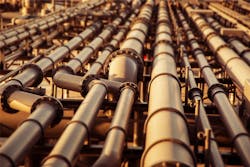Quiz Corner: Weep and vent hole orientation in horizontal pipe
How should weep holes and vent holes of an orifice plate be oriented in a horizontal pipe?
A. Top of pipe
B. Three o’clock position
C. Bottom of pipe
D. Nine o’clock position
E. Side of the pipe
The idea behind weep holes and vent holes is to remove the fluid in the nonflowing state from the flow measurement system.
For gas service, the weep hole should be located at the bottom of the pipe (Answer D) to allow liquids that may be present upstream of the orifice plate to pass downstream.
For liquid service, the vent hole should be located at the top of the pipe (Answer A) to allow noncondensable gases that may be present upstream of the orifice plate to pass downstream.
Additional complicating factors
Orifice calculations should compensate for the flow that passes through the weep holes and vent holes during normal flowmeter operation.
About the Author
David W. Spitzer
David W Spitzer’s new book Global Climate Change: A Clear Explanation and Pathway to Mitigation (Amazon.com) adds to his over 500 technical articles and 10 books on flow measurement, instrumentation, process control and variable speed drives. David offers consulting services and keynote speeches, writes/edits white papers, presents seminars, and provides expert witness services at Spitzer and Boyes LLC (spitzerandboyes.com or +1.845.623.1830).
